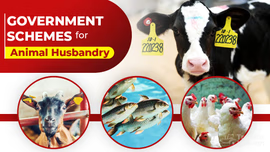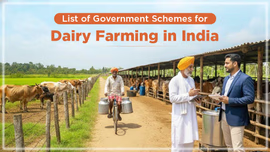
Agriculture has long been a part of human civilization. Various methods and practices have been introduced and refined over time to enhance agricultural productivity. Recently, drones have been used to improve different aspects of agriculture as they offer several advantages, including improved accuracy, efficiency and profitability. Read today's blog to learn the various aspects of drones in agriculture.
Table of Contents
- Introduction to Agriculture Drones
- What are the Applications of Drones in Indian Agriculture?
- What are the Benefits of Drones in Agriculture?
- What are the Major Challenges in Using Drones in Agriculture?
- What are the Government Regulations for Using Drones?
- What are the Government Initiatives for Agriculture Drones in India?
Introduction to Agriculture Drones
Around 47% of the Indian population depends on agriculture for their livelihood, and they help boost productivity and ensure food security for the country. As the world is modernizing, so is the agriculture sector in India. Productivity in the agriculture sector can be improved using advanced technology and computerized solutions. One of the best examples of technology that helps improve productivity in agriculture is the use of drones.
Drones, which are commonly known as UAVs (Unmanned Aerial Vehicles), are used in agriculture for many purposes, such as farmland & soil assessment, crop health, spraying, irrigation, plantation, and livestock monitoring. Let's discuss the role of drones in transforming Indian agriculture, their applications, benefits, challenges, government regulations, government initiatives and their future scope.
What are the applications of Drones in Indian Agriculture?
Drones are used in different aspects of agriculture. The common applications of drones in Indian agriculture are:
Farmland & Soil Assessment
Drones are used for field monitoring to collect data regarding the soil health and field conditions. Drones can offer accurate field mapping, such as elevation information, which helps you learn about any irregularities in the field. The field elevation information will help you determine drainage patterns and wet/dry spots, and use efficient watering techniques for irrigation. Some drones also provide nitrogen level monitoring in soil using improved sensors. It helps in precise application of fertilizers, reducing poor growing spots and enhancing soil health for years to come.
Scouting/Monitoring Crop Health
Drones have achieved great success in monitoring crop health. They come with special imaging equipment, known as Normalized Difference Vegetation Index (NDVI), that uses detailed colour information to indicate crop health. It helps you monitor crops as they grow so that any issues can be dealt with quickly to save the crops.
Drones with 'regular cameras' can also be used to monitor plant health. Some farmers already use satellite imagery to monitor the growth, density, and colouration of the plant. However, getting access to satellite data is expensive and not effective in many cases compared to closer drone imaging. Drone imaging can produce accurate image location to the millimetre, which means regions with stand gaps can be spotted easily after planting and replanted when required. It also ensures that the disease and pest issues can be detected and treated quickly.
Spray Applications
Drones can also be used for spray applications as they can efficiently perform site-specific spraying of pesticides and fertilizers on the farms, reducing manual labour. You can use sensors to scan the region in real-time. Drone spraying is five times faster than traditional spraying methods. It improves spraying accuracy and saves time and cost in the long run. Prior adjustment to the speed, altitude and spraying accuracy is highly useful even in difficult terrains. The advantage of using drones for spraying is that it reduces the direct involvement of humans during the spraying of hazardous chemicals.
Irrigation Management
Drones, equipped with thermal sensing cameras, offer an exceptional perspective into specific troubled areas of the farm for irrigation. These digital cameras can help monitor many insights, from low moisture-stressed conditions to waterlogging. It allows farmers to make irrigation management decisions according to the status of water in the soil. It helps in precision water application on the farm.
Plantation
Seed plantation is one of the latest and less widespread uses of drones in agriculture. The forestry industry is now widely using automated drone seeders. However, drones have the potential for more widespread use on the horizon. Planting with drones means areas that are very hard to reach can be replanted without endangering workers.
Livestock Monitoring
Animal husbandry also uses drones. RFID tags are marked on animals, and their activity is monitored using drones. Livestock tracking can be done with less labour investment and less time. Farmers can create remote sensing-fencing or virtual boundaries in regions with vast livestock grazing areas.
What are the benefits of Drones in Agriculture?
- Improved Accuracy: Drones for agriculture purposes can provide data through high-resolution images of farms. Thus, you will get a detailed view of the farm and make the necessary adjustments on time with improved precision.
- Improved Efficiency: You can easily gain substantial information regarding the field using drones, which can cover a large area in one go. It allows you to monitor the crops and farms based on the collected data, thus tweaking things to improve overall productivity.
- Profitability: Drones can increase overall profitability by reducing dependence on manual labour. Drones can accurately and precisely identify these areas, helping to reduce the cost of pesticides by limiting their use to specific parts only.
- Improved Yield: Drones can help gather crop health information and data, allowing us to take timely action, thereby protecting the crop and increasing yield.
What are the major challenges in using Drones in Agriculture?
Weather Dependent
Drones may not perform optimally in challenging weather conditions, such as harsh rainfall or strong winds, thus limiting their use in these conditions.
Technical Skills
While drones in farming offer benefits, they require suitable technical skills to operate a drone, which farmers cannot gain without training. However, the government offers drone training programs to help farmers develop the skills and expertise necessary for operating drones. Also, 63 DGCA-approved Remote Pilot Training Organisations provide drone training in India.
Cost Factor
High-quality drones come with advanced sensors, which can be costly for small and marginal farmers, who are the backbone of Indian agriculture. However, the initial investment may be expensive, but the operational cost will be within the budget of farmers. Many subsidy schemes, like those provided under SMAM, can help fill this gap, but wider accessibility will remain a challenge.
What are the Government regulations for using Drones?
Government regulations play an important role in shaping the use of drones in agriculture. It influences how drone technology in agriculture can be used, its deployment, potential benefits and safety.
A license from the Directorate General of Civil Aviation (DGCA) is required to operate drones for agriculture purposes. This is to prevent any airspace violation and protect privacy. This is to ensure several aspects related to airspace management, data security, national security, safety of others, environmental impact, and legal consequences.
What are the Government Initiatives for Agriculture Drones in India?
Agriculture drones are used for the survey of land, inspection, spraying and damage assessment. It helps farmers identify the problems in the field and solve them easily and efficiently. However, farmers require technical skills to operate drones for agriculture, which can be obtained through training. The government has taken major steps to enhance the use of drone technology in agriculture. It has launched many schemes and programs for drone technology, and some of them are discussed below:
Pradhan Mantri Drone Didi Yojana
Under this scheme, 15,000 women-led Self-Help Groups are eligible to get agriculture drones for their farming needs. It offers employment opportunities, improves productivity, and helps deliver essential items.
Kisan Drone Scheme
The scheme aims to empower farmers through the use of drones to streamline diverse farming tasks like irrigation and crop spraying to reduce labour and time and increase farmers' income.
Indian Council of Agricultural Research affiliated institutes, Central Government Agricultural Institutions, State Agriculture Universities, Public Sector Undertakings and Krishi Vigyan Kendra can avail full financial support for drone technology in agriculture, covering 100% of the cost up to 10 lakhs per drone.
Hiring centres affiliated with the Farmer Cooperative Society offer up to 4 lakhs or 40% in the procurement of drones.
Farmers in the North-Eastern States and marginal farmers are eligible for financial aid of 50% in drone acquisition up to 5 lakhs.
Frequently Asked Questions On Drones in Indian Agriculture
1. What are the applications of drones in agriculture?
Drones can be used for various activities such as farm & soil assessment, crop health monitoring, spraying, irrigation, plantation and livestock monitoring.
2. What is the importance of drones in farming in India?
Drones offer various advantages in farming, such as reduced cost, increased yield, and improved efficiency, which shows their importance in farming.
3. Is there any subsidy available for drone usage in farming?
There are several schemes for drones in India, such as Pradhan Mantri Drone Didi Yojana, Kisan Drone Scheme, and other financial assistance programs, to promote drone farming.
4. What is the Kisan drone scheme?
The government aims to encourage farmers to use drones in farming to streamline diverse tasks like spraying, reduce costs and save time.
5. Are drones affordable for farming purposes?
Drones are affordable for farming as they reduce operating costs and physical labour. Drones also optimize overall use with precise spraying, seeding, and surveying.
6. Is a licence required to use drones in agriculture?
A license from the Directorate General of Civil Aviation (DGCA) is required to operate drones for agriculture purposes.
7. Which kind of drone is used for agriculture?
Fixed-wing drones are used in agriculture to identify any issues, monitor the crops and map the fields.


Related Blogs












